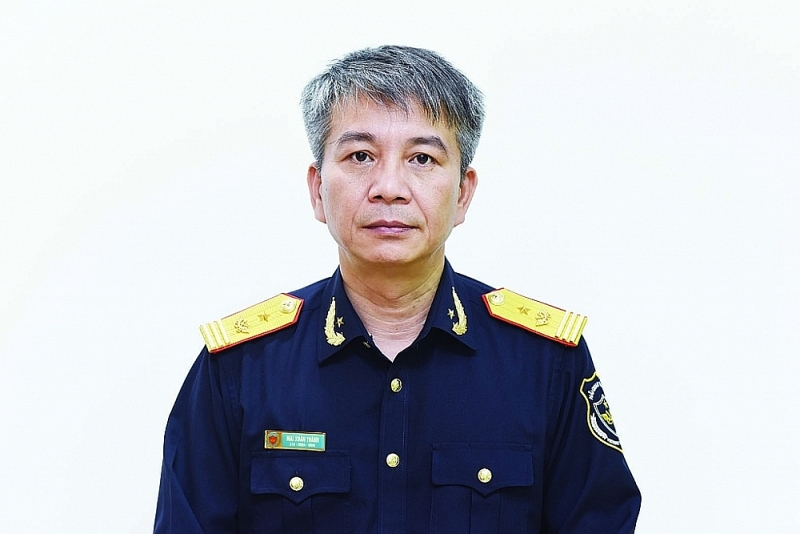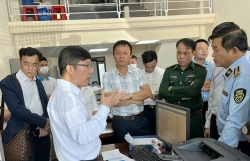 |
| Deputy Director General of the General Department of Customs Mai Xuan Thanh |
What role does digital transformation play in customs reform and modernization, sir?
Deputy Director General Mai Xuan Thanh:
Over the past 20 years, along with the development of the country, the Customs sector has strengthened reform and modernization, in which the application of information technology (IT) is considered the driving force and the key to reform, development and modernization.
So far, the General Department of Customs has nearly reached the goal of building e-customs with 5E (E-Declaration, E-Payment; E-C/O, E-Permit and E-Manifest) on IT application in state management of Customs, building a centralized IT system at the General Department level to serve the state management of customs and support most of the key fields on customs management.
The VNACCS/VCIS has been deployed at 100% of customs branches nationwide. In 2022, the system handled more than 14 million import and export declarations, of which 65.33% are Green channel, 30.41% Yellow channel and only 4.26% Red channel. Notably, the clearance time for Green channel declarations only takes a few seconds.
Further, the Customs sector has invested and put into use a lot of modern equipment. In 2022 alone, the customs authority accepted and handed over 13 customs surveillance camera systems, three camera observation rooms, one outside luggage scanner, two cargo baggage scanners and four outside container scanners. The equipment contributes to speeding up customs clearance of goods for businesses and improving management efficiency.
On August 2, 2022, the Director General of the General Department of Customs signed and promulgated Decision No. 1660/QD-TCHQ establishing the Steering Committee and the Working Group for the Digital Transformation of the General Department of Customs. In 2022, the Steering Committee held a meeting to implement related tasks and develop working regulations and plans In 2023, the Steering Committee will focus on directing all customs units to implement the digital transformation-related goals and tasks to meet the requirements of progress and quality, to soon complete the digital transformation target. |
The Customs Development Strategy to 2030 also set a general goal that by 2030 “Building a professional and modern Vietnam Customs, on par with the Customs administrations of developed countries in the world, leading in implementation” Digital government, with the Digital Customs, Smart Customs”.
The Strategy aims to “take reform and modernization as the basis, modernization of the customs management model as the focus, promote the digital transformation in the Customs as the foundation for Customs development in the new period”.
Moreover, along with the international trend, the inevitability of the modernization cycle, and the policies of the Party, the Government and leaders at all levels on promoting digital transformation and the application of technologies of the Industrial Revolution 4.0, the General Department of Customs has issued the Digital Transformation Plan to 2025, with a vision to 2030.
It can be said that digital transformation plays a very important role in the customs modernization process. It helps simplify procedures, cut time and costs for businesses and improve the efficiency and effectiveness of State management.
What are the key targets of the Customs sector in digital transformation?
Deputy Director General Mai Xuan Thanh:
Under the Digital Transformation Plan, the Customs sector aims to achieve digital Customs by 2025, with the following targets:
100% of customs procedures are digitized and processed online;
95% of documents in customs dossiers are converted into digital data;
100% of dossiers on organizations and individuals related to export and import activities; people and means of transport on exit, entry or in transit; and imported, exported and transited goods are managed in the form of digital data;
100% of basic customs records are converted to electronic data, moving towards digitization;
100% of administrative procedures with high demand are provided with online public service level 4 and are accessible by many devices;
80% of customs inspection activities are performed through the digital environment and IT system of the General Department of Customs;
100% of administrative procedures in the field of licensing, specialized inspection for export, import and transit goods are processed through the National Single Window.
For internal governance, 100% of state agencies’ internal direction, administration and governance activities are carried out on the basis of overall and unified governance; 100% of records are created, kept and shared online according to regulations; 100% of cadres, civil servants and public employees are trained on basic digital skills.
The General Department of Customs set the targets to finish the transformation by 2025 and complete the smart customs model in 2023.
To achieve the set targets, which key tasks should the customs sector focus on?
Deputy Director General Mai Xuan Thanh:
Three important tasks the customs must focus on in 2023 and in the near future are:
Firstly, implementing digital transformation in customs operations. Accordingly, the General Department of Customs is taking efforts to complete the overall redesign of the IT system to meet the requirements of performing digital customs task. In which, the customs authority will conduct a comprehensive review of current operations, building processes to ensure continuity, meet management requirements and comply with international standards and practices and create conditions for the strong application of IT and the technologies of the Industrial Revolution 4.0.
Based on the results of the overall redesign of operations, in the 2021-2025 period, the General Department of Customs built an IT system to meet the requirements of digitizing operations.
Secondly, conducting digital transformation in the implementation of the National Single Window (NSW) and the ASEAN Single Window (ASW). To realize this task, the General Department of Customs continues to work with ministries and sectors to organize the implementation of the following contents:
100% of administrative procedures in the field of licensing, specialized inspection for export, import and transit goods are carried out through NSW.
Develop a Government Decree on connecting and sharing information between Government agencies and stakeholders through NSW in the field of import, export and transit of goods.
Building and deploying centralized IT systems and implementing NSW and ASW.
Thirdly, implementing the project on building a national database on customs. Accordingly, the General Department of Customs will work with experts in the Trade Facilitation Project (TFP) in consulting, surveying and formulating projects.
In addition to the three key tasks, the General Department of Customs will carry out other tasks such as digital transformation in internal management; develop systems to connect and share intra-industry information according to the centralized connection model; implementing digital transformation to serve import-export enterprises; building foundation services to deploy the e-Government of the Customs authority and perfecting the platform for providing online public services.
 | Digital border gate platform to be improved to avoid overlaps |
The General Department of Customs also continues to promote the research and application of Industry 4.0 technologies such as artificial intelligence (AI), internet of things (IoT), and big data analysis (Big Data).
Thank you very much,
